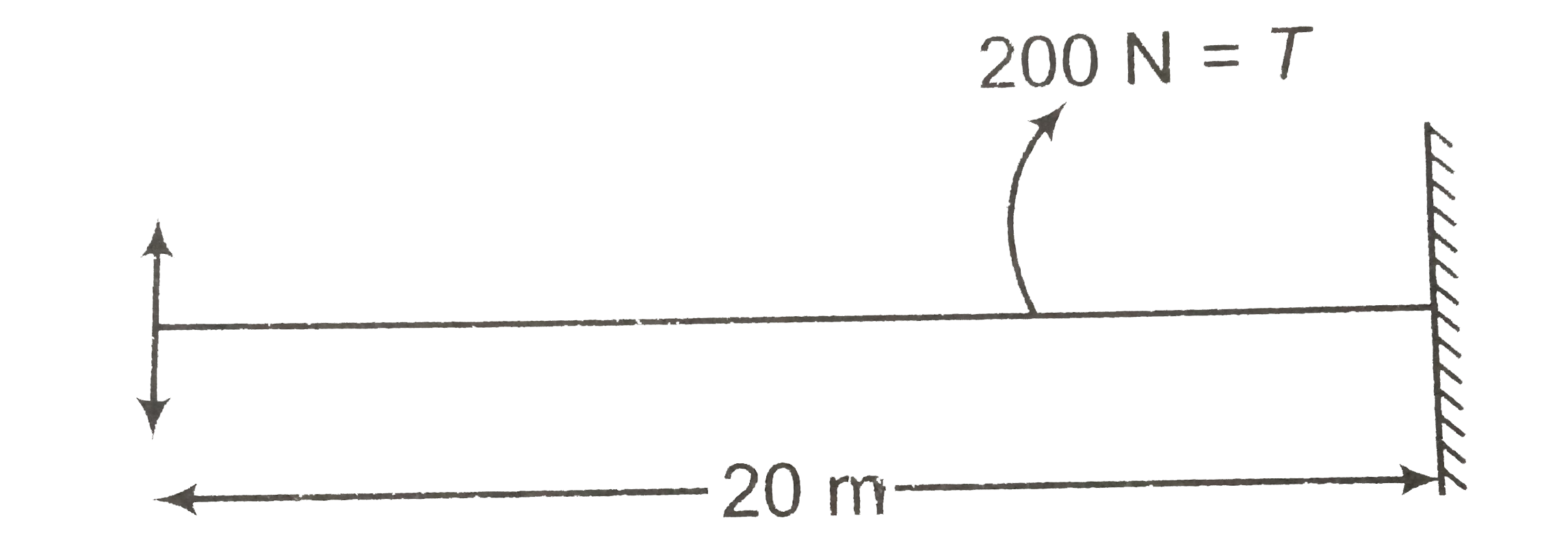Selected Problems (From Wave Equation, Intensity , Energy Density) from S CHAND PHYSICS (ENGLISH) WAVES for Class 11
| Class 11 | PHYSICS |
| Chapter | WAVES |
| S CHAND PHYSICS (ENGLISH) | Selected Problems (From Wave Equation, Intensity , Energy Density) |
| Medium | English |
| Academic Year | 2023-2024 |
Question 24
A wave travelling along the length of a string is shown in Fig. 14.4.12. Using the scale on the given axis, find
(i) The amplitude of the wave
(ii) The wavelength of the wave
(iii) If the frequency of the wave is 10 Hz, What is the speed of the wave?
(iv) What is the initial phase of the wave ?
(v) What is the phase difference between two points separated by a distance 10 cm ?
(vi) If this wave is made to travel through water what is the wavelength of the wave, if the speed of, the waves in water is 10 m/s.
 View Solution
View SolutionQuestion 31
Two persons stand near a railway line separated by a distance 2 km. A detonator is exploded by the first person. The second person 2 km away hears two sounds, one from the sound that has travelling through the rail and the other through the air. What is the interval between them? Given Young's modulus of steel =2×1011N/m2. Density of steel = 8000 kg/m3. Density of air = 1.29 kg/m3. Atmospheric pressure =1×102N/m2. y for air = 1.4View SolutionQuestion 75
An excited tuning fork of frequency 512 Hz is held over the open end of a tall jar and water is slowly poured into it. Resonance was first observed at a level and then at a higher level. Calculate the difference in heights of the two levels. Velocity of sound in air at the time of experiment is 346 m/s.View SolutionQuestion 80
A copper rod 1 m long and clamped at a point distant 25 cm, from its end is set in longitudinal vibrations and is used to produce stationary waves is a Kundt's tube containing air at 30∘C. Heaps of lycopodium dust are found to be 4.95 cm apart. What is the velocity of longitudinal waves in copper ? Velocity of sound in air at 0∘C= 332 m/s.View SolutionQuestion 81
A rod 100 cm in length and of material of density 8×103 kg/m3 is clamped at the centre and attached to a Kundt's tube containing air. The distance between the first and the tenth node when the rod is stroked longitudinally is 135 cm. If the velocity of sound in air is 330 m/s determine the Young's modulus of the material of the rod.View SolutionQuestion 83
In Melde's experiment when the tension is 100 gm and the fork vibrates at right angles to the direction of the string, the latter is thrown in four segments. If now the fork is set to vibrate along the string, find what additional load will make the string vibrate in one segment ?View SolutionQuestion 102
A train standing at the outer signal of a railway station, blows a whistle of frequency 400 Hz in stil air. (i) What is the frequency of the whistle for a platform observer when the train (a) approaches the platform with a speed of 10ms−1. (b) recedes from the platform with a speed of 10 ms ? What is the speed of sound in each case? (V=340ms−1).View SolutionQuestion 105
A car B, with a hom of frequency 700 Hz moves with a velocity 90kmh−1. It approaches another car A, coming towards it with a velocity 72kmh−1. Calculate the apparent frequency of the sound heard by the driver in the car A (a) before crossing (b) after crossing ? Velocity of sound =350ms−1.View SolutionQuestion 106
A source and an observer is approaching closer with a relative velocity of 40ms−1. If the true frequency of the source is 1200 Hz calculate the observed frequency under these conditions: (i) the source alone is moving (ii) the observer alone is moving. Take velocity of sound in air to be 340ms−1.View SolutionQuestion 108
A whistle of frequency 500 Hz is rotated in a circle of radius cne metre with an angular speed of 10 radian/sec. Calculate the lowest and the highest frequency heard by a listener at a long distance away at rest with respect to the centre of the circle ? (Velocity of sound = 340m/s)View SolutionQuestion 114
Microwaves are reflected from a distant airplane approaching a stationary observer. It is found that when the reflected waves beat against the waves radiating from the source, the beat frequency is 900 Hz. Calculate the approach speed of the airplane if the wavelength of the microwave is 0.1 H. Velocity of microwave is 3×108 m/s.View SolutionQuestion 119
The graph below shows the instantaneous displacements due to a progressive longitudinal wave travelling with velocity 40ms−1. along the line ABCD. (See Fig. 14.4.13).
(a) What is the frequency of the particles of the medium ?
(b) What is the phase difference between vibrations at A and B ?
(c) At which of the points A, B, C, D is the instantaneous particle velocity maximum forward ?
(d) At which of the points A, B, C, D is there a compression ?View Solution
All Exercises from S CHAND PHYSICS (ENGLISH) Class 11 PHYSICS WAVES
- ADDITIONAL SOLVED PROBLEMS
- MUSICAL SOUND
- SOUND WAVES
- CONCEPTUAL SHORT ANSWER QUESTIONS WITH ANSWERS
- LONG ANSWER QUESTIONS
- SHORT ANSWER QUESTIONS.
- SUPERPOSITION OF WAVES, BEATS, STATIONARY WAVES
- DOPPLER EFFECT, MUSICAL, SOUND, NOISE
- VERY SHORT ANSWER QUESTIONS
- FROM BEATS
- FROM DOPPLER EFFECT
- FROM MUSICAL SOUND
- FROM ORGAN PIPES
- FROM SOUND WAVE VELOCITY
- SELECTED PROBLEMS (FROM WAVE EQUATION, INTENSITY , ENERGY DENSITY)
- SOLVED EXAMPLES
- WORKED OUT EXAMPLES (MODULE -1)
- WORKED OUT EXAMPLES (MODULE -2)
- WORKED OUT EXAMPLES (MODULE -3)
